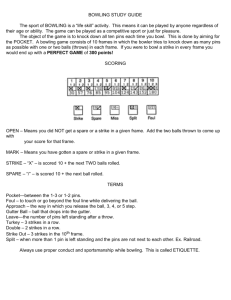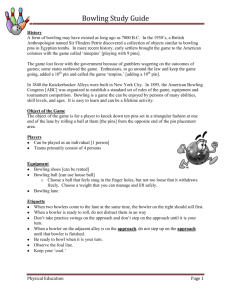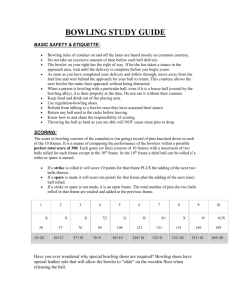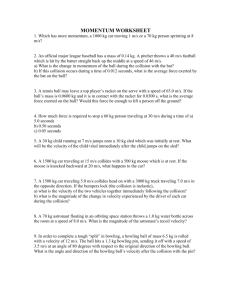Bowling Skills Assessment
advertisement
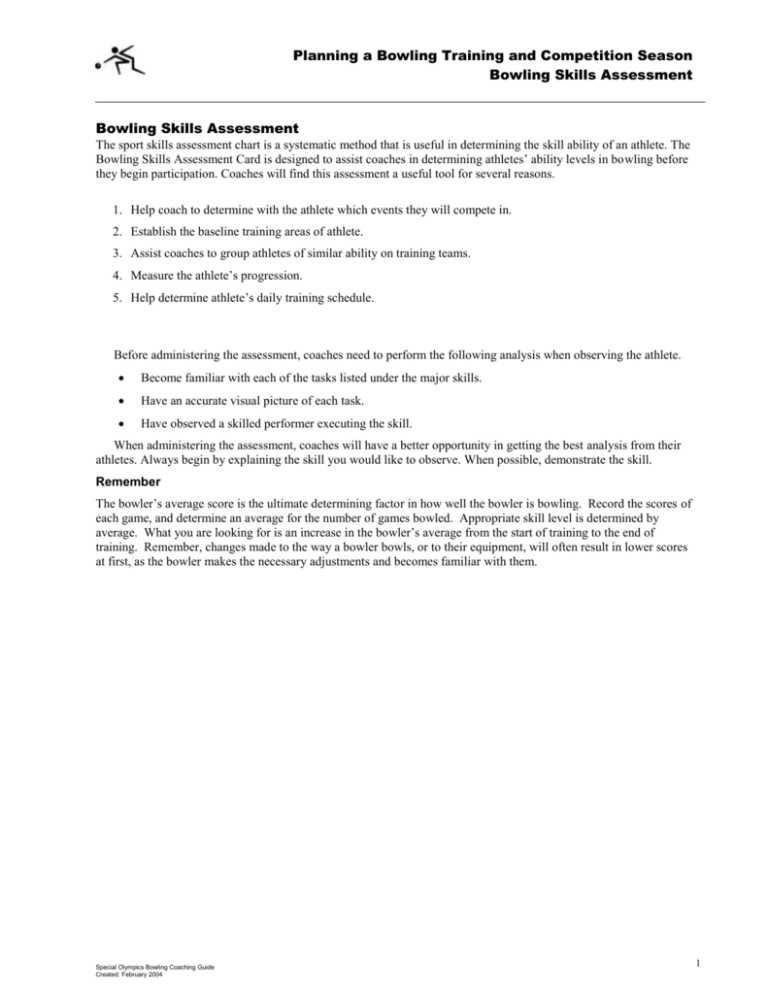
Planning a Bowling Training and Competition Season Bowling Skills Assessment Bowling Skills Assessment The sport skills assessment chart is a systematic method that is useful in determining the skill ability of an athlete. The Bowling Skills Assessment Card is designed to assist coaches in determining athletes’ ability levels in bowling before they begin participation. Coaches will find this assessment a useful tool for several reasons. 1. Help coach to determine with the athlete which events they will compete in. 2. Establish the baseline training areas of athlete. 3. Assist coaches to group athletes of similar ability on training teams. 4. Measure the athlete’s progression. 5. Help determine athlete’s daily training schedule. Before administering the assessment, coaches need to perform the following analysis when observing the athlete. Become familiar with each of the tasks listed under the major skills. Have an accurate visual picture of each task. Have observed a skilled performer executing the skill. When administering the assessment, coaches will have a better opportunity in getting the best analysis from their athletes. Always begin by explaining the skill you would like to observe. When possible, demonstrate the skill. Remember The bowler’s average score is the ultimate determining factor in how well the bowler is bowling. Record the scores of each game, and determine an average for the number of games bowled. Appropriate skill level is determined by average. What you are looking for is an increase in the bowler’s average from the start of training to the end of training. Remember, changes made to the way a bowler bowls, or to their equipment, will often result in lower scores at first, as the bowler makes the necessary adjustments and becomes familiar with them. Special Olympics Bowling Coaching Guide Created: February 2004 1 Planning a Bowling Training and Competition Season Bowling Skills Assessment Special Olympics Bowling Skills Assessment Card Athlete’s Name Date Coach’s Name Date Instructions 1. Use tool at the beginning of the training/competition season to establish a basis of the athlete’s starting skill level. 2. Have the athlete perform the skill several times. 3. If the athlete performs the skill correctly three out of five times, check the box next to the skill to indicate that the skill has been accomplished. 4. Program assessment sessions into your program. 5. Bowlers may accomplish skills in any order. Athletes have accomplished this list when all possible items have been achieved. Layout of the Bowling Area Knows where the control counter, lounge area and bowling area are located. Can identify the pit area. Can identify the approach area. Can identify the foul line/foul light and understand their functions. Can identify the ball return. Can identify the automatic scoring equipment. Understands how the balls are returned and the operation of the ball return equipment. Equipment Selection Understands where to locate shoes and ball. Asks appropriate person for correct bowling shoe size. Selects appropriate weight for a ball. Wears clothing that is comfortable and provides freedom of movement. Returns bowling ball and shoes to appropriate place after game. Scoring Understands to count pins knocked down. Recognizes strikes and spares. Understands basic terminology (i.e., open, split, strike, spare). Understands method of scoring. 2 Special Olympics Bowling Coaching Guide Created: February 2004 Planning a Bowling Training and Competition Season Bowling Skills Assessment Rules of the Game Shows an understanding of the game. Understands that the game consists of 10 frames. Knows which lane to bowl on when alternate lanes are being used. Knows not to cross the foul line when bowling. Knows that pins knocked down when a foul is committed do not count. Knows to bowl only one ball in a frame when a strike is scored. Knows to bowl no more than two balls per frame, unless in the 10th frame where three balls may be permitted. Knows to bowl only when pins are standing. Adheres to the rules of the bowling area. Follows official Special Olympics and ABC bowling rules. Sportsmanship/Etiquette Exhibit sportsmanship and etiquette at all times. Demonstrate competitive effort at all times. Takes turns with other team members. Selects and uses the same ball throughout the game. Waits for bowlers on adjacent lanes (one lane right or left of athlete) to finish before bowling. Bowls cooperatively and competitively; cheers fellow teammates. Maintains knowledge of own score. Helps teammates with their scores. Retrieving the Ball Observes lane courtesy. Approaches ball return from correct side. Identifies own ball. Picks up ball correctly from ball return. Cradles the ball in one arm and moves to the starting position on the approach. Grip Places fingers and thumb in the ball properly. Supports the ball by placing the nonbowling hand under the ball with elbows in. Special Olympics Bowling Coaching Guide Created: February 2004 3 Planning a Bowling Training and Competition Season Bowling Skills Assessment Stance Locates starting position on approach. Stands appropriately for making spares. Demonstrates proper foot placement - left foot forward, if right-handed. Assumes correct stance with eyes focused on bowling pins or target arrows/dots. Holds ball under control with two hands. Holds ball at proper height relative to body position. Approach Performs pendulum swing without push away. Performs pendulum swing with push away. Performs, without consistent rhythm three-, four-, five-step approach with push away and pendulum swing. Performs smooth three-, four-, five-step approach with push away and pendulum swing. Delivers ball without going over the foul line. Delivery Last step is a slide forward toward the foul line. Ball is delivered over the foul line toward the pins or target mark. Performs two-handed pendulum swing in straddle-standing position. Executes proper follow-through with arm swing. 4 Special Olympics Bowling Coaching Guide Created: February 2004

